From A to V
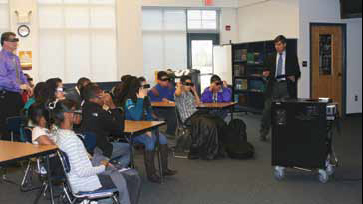
Audio-visual technology—or the use of sound and pictures to convey information—has come a long way in a short time. We’ve gone from overhead projectors and impossible-to-program VCRs to flat-screen displays and affordable digital videocameras. As you’ll see from the schools in the following stories, student creativity is at an all-time high. Students are producing news programs and podcasts, filming in-class trials, and even staying after school voluntarily to do these projects.
PROJECTORS 'R US
Meet Karen Bessey, this year’s winner of Casio’s Mobile Classroom Package. When Bessey—media coordinator/tech facilitator at Darden Middle School in Wilson, North Carolina—received an email telling her she’d won the contest, she thought it was a prank. A few days later, the company called to deliver the news. Now her already AV-savvy school will get to enjoy $12,000 worth of brandnew equipment, including a short throw projector, pen, and software, 30 pairs of 3D glasses, and an AVRover cart equipped with a 3D computer.
A Rich AV History
Darden Middle School students using their 3D glasses to see a beating heart. Teachers at Darden Middle School have always used audiovisual equipment. Each core-subject teacher has a projector, laptop, and a Discovery Education streaming account. Many of them customize assignments so that students need only log in to Discovery to see prompts of the videos and clips they should watch and the activities to complete.
In addition to showing videos, many teachers use Flip video cameras. One language arts class conducted a mock trial with characters from a novel they read. They filmed and edited the trial with MovieMaker. Another language arts class wrote and filmed a commercial about the novel they read. A different group of students recorded poems they wrote, used Audacity to add music, and them uploaded the poems.
When students complete one of these projects, they can project it to the classroom. All classes have TVs that are connected to a video-retrieval system. Every morning, Bessey works with students to produce a news show of oneminute clips of happenings around the school, such as math students practicing measuring or science students’ skits about the bad effects of smoking.
Tools and ideas to transform education. Sign up below.
“We are doing more and more student-generated projects because the kids love them,” Bessey says. “They stay after school until 5:00 to learn how to edit and use the software. When they produce something that their peers will watch, they work even harder on it.”
Future Projections
As soon as she received her Mobile Classroom Package, Bessey began playing with the new products. “With the short throw projector you can get very close to the screen,” she says. “It’s a great tool to help teachers in all subjects bring a strong visual component to their lessons.
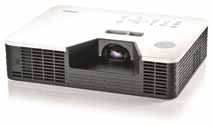
She was equally thrilled with the 3D files that came with the 3D computer, especially the one of the heart. Already, seventh-grade science teachers have used it for lessons. “You can use the mouse to twirl it around and see the blood vessels and the heart’s chambers,” Bessey says. “With the 3D glasses it looks like it’s pumping in front of you.”
Recently, Casio sent Bessey software that will let her convert 2D files to 3D. She is hoping to turn student-created timelines into 3D images to help illustrate books and will soon hold training sessions during planning time to get everyone up to speed.
RAISE YOUR VOICE
These cool online tools let teachers add audio to the classroom
By Julia K. VanderMolen
Discovering ways to keep students interested, attentive, and highly engaged can be a challenge. But thanks to a variety of voice and audio tools, teachers can take communication and collaboration to the next level. Whether you want to notify students about upcoming projects or provide them with feedback on assignments, these Web sites will help you get the task done more interestingly.
Dr. Julia VanderMolen is the department coordinator and assistant professor for health and science online with Davenport University. She works with online adjunct faculty to integrate new technologies and ideas to enhance the student online learning experience.
VoxoPop (www.voxopop.com)
VoxoPop lets teachers record audio message to express ideas, ask questions, and provide feedback on assignments and projects. In the online classroom, VoxoPop is a great way to provide audio introductions for both the teacher and the student. Best of all, you can load threads into iTunes as a podcast with chapters.

AudioBoo (audioboo.fm)
AudioBoo is a website and smartphone application designed to allow users to post and share sound files. It allows a teacher or student to record and play back digital recordings of up to five minutes long that can then be posted on the AudioBoo website (where users have their own pages). It lets students create, collaborate, publish, and interact with peers, experts, and other audiences. AudioBoo can be used for any curriculum area.
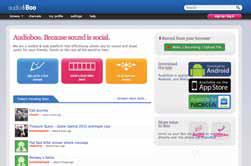
Vocaroo (vocaroo.com)
Vocaroo is a wonderful voice-recording tool that allows teachers to seamlessly and instantly record and share voice feedback. For instance, teachers can record what they say instead of trying to keep notes and possibly miss some information. Teacher can also embed the tool into a course website or LMS. The site also provides a link to create a QR code. What a great way to create a Web-based audio scavenger hunt.
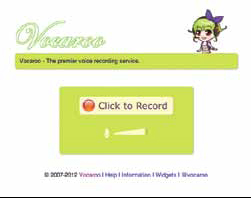
Other audio and visual tools for teachers to explore:



• Audacity (audacity.sourceforge.
net): open-source audio editor and recorder • Blackboard Collaborate (www.blackboard.com/Platforms/Collaborate/Overview.aspx):
collaboration software • Chirbit (www.chirbit.com):
record, upload, and share audio files


• Talkshoe (www.talkshoe.com):
create, join, or listen to live interactive discussions, conversations, podcasts, and audioblogs
• Woices (woices.com):create,
share, and consume echoes, which are audio records that are linked to geographical location or real-world
object
NEW LIFE TO OLD SYSTEMS
Paintsville High School (PHS) in Kentucky figured out a low-cost solution to revive a 40-year-old, nearly dysfunctional TV system. Here’s how.
1. Cat 6 was installed at PHS in July 2010, replacing both Cat 5e cabling for the school’s data network and aging coax cable for cable TV distribution. 2. Not long after the new cable was in place, Lynx Broadband let the school test its equipment at minimal cost. 3. PHS spent approximately $5,700 to
complete the new TV system, including the cabling, equipment for distributing TV signals throughout the school, ceiling projectors, and flat screen TVs. 4. Each hub splits incoming coax signals from Suddenlink Cable TV and uses RF baluns to convert them to balanced signals. The signals then travel from a Lynx hub (shown in photo) to a patch panel, then to classrooms, all on Cat 6 cable. 5. “Installation was pretty much cut and dried,” says Craig Ratliff (left), technology assistant. 6. “Finding and fixing faulty connections is easy, unlike the coax system where it was extremely time-consuming to locate trouble spots,” says Joe Schmitt, technology director. 7. The next major phase of the project will be to install HD tuners from SuddenLink ahead of all the projectors. When fully upgraded, the school will have access to 93 digital channels, including a number of HD channels. 8. The new system went live in March 2011, providing sharp, clear pictures in 23 classrooms.

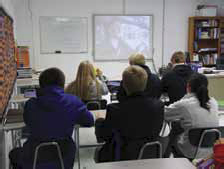
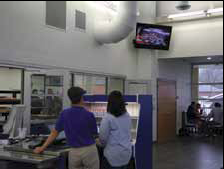


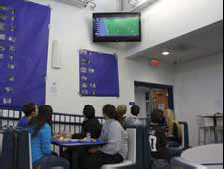

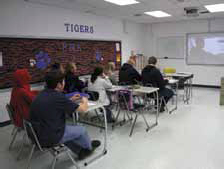
BROADCAST NEWS, TEXAS STYLE
THS students edit a segment for the daily broadcast. Many traditional broadcast outlets don’t have the demanding schedule that Texas High School’s TigerVision has. For the 175 students involved in the program, their school day consists of standard classes and sports, as well as maintaining a high-quality television station that pumps out daily and weekly cable and streamed content. All on a public school budget.
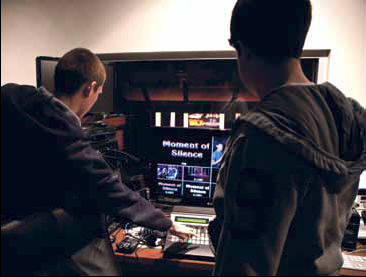
Texarkana’s Texas High School (THS) has always prided itself on being able to offer real-world learning experience at state-of-the-art facilities. The public school is well known for competitive sports and boasts famous alumni who have gone on to become politicians and professional athletes. Even the facility itself is widely acknowledged as an architectural beauty.
A Multimedia Dream
THS’s programs include an exceptional multimedia department, giving students from grades 8 to 12 a unique chance to produce broadcast-quality content. TigerVision is THS’s student-run television station, broadcast campus-wide, locally on cable, and online at www.tigervision.org. Daily programming includes a 10-minute campus broadcast, student interviews, Tiger Theatre Company’s original series, hour-long locker room shows during athletic seasons, and digital-signage content that is broadcast on three local cable channels over the course of the year.
Instructor Charles Aldridge may consider himself a teacher first and a video professional second, but at THS the two go hand in hand. He has built and continues to grow a television studio that includes HD cameras and monitors, professional-level editors, and equipment for streaming and playback, all used and maintained by a group of ever- changing amateur cameramen, editors, and production crews. To make this all happen smoothly and reliably, Aldridge relies on a plethora of equipment.
Students learn how to film everything from sports events to spelling bees. The theatre control booth and the TigerVision studio are equipped with three Panasonic AG-HPX300 cameras, two Blackmagic Design DeckLink HD Extremes, and three DeckLink HD Extreme 3D cards for capture, playback, keying and graphics. Editing is done with a combination of Final Cut Pro on a Mac Pro and a Panasonic 400 HD switcher for the theatre. Live playback is handled by the DeckLink cards and a Softron OnTheAir Video Express license, which playout to Panasonic 10K HD projectors in house, as well as out to the community and Internet.
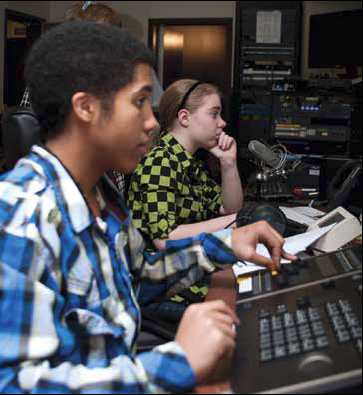
“We have about 175 students in the program with a variety of experience,” says Aldridge. “They begin in the eighth grade, finishing daily shows for the middle school in the TigerVision Jr. program. As high school freshmen, they learn all the basics, from terminology to technique. They enter their sophomore year running, learning all aspects of shooting, editing, and ‘telling the story’ in a very hands-on environment.”
Aldridge says TigerVision’s curriculum is AV heavy, and students produce live programming to be streamed across the campus, on cable, and online. “With daily student shows, weekly sporting events, and frequent theatre productions, this essentially means their work is never ending,” he adds.
Moving Forward
Although programming is currently broadcast in standard definition (SD) across the campus, students shoot and edit in HD and playback the HD LIVE through a DeckLink HD Extreme that downconverts to SD on the fly. The goal is to eventually transform into a full HD operation. The DeckLink’s ability to handle both SD and HD material easily will allow for an efficient transition to a full HD studio without costly reinvestment in new technology.
Aldridge just returned from the Student Television News Convention in Dallas, at which TigerVision won $10,000 from the first Annual U.S. Education TV Awards, honoring them in the “Best Live Event” and “Most Innovative Use of Platform” categories. “For a high school program, we’re a bit ahead of the technology curve, so it was wonderful to not only receive this level of recognition, but also to earn some extra funds that will expedite the transformation to HD.”
AN AV EXPERT SHARES HIS EXPERIENCE
Gordy Wenum is the media specialist/technology coordinator for Lakeville South High School and the district video coordinator for Lakeville Area (MN) Public Schools. He is also the 2011 winner of the Outstanding Minnesota AV /Media Coordinator Award, sponsored by Alpha Video. T&L editors recently chatted with Wenum about his award-winning production department.
Tell us about AV in your district.
We try to keep the tools in the classrooms fairly basic so that teachers can use them easily. Most classes have projectors on carts with DVD/VHS players and VGA hookups for computers. A few teachers, particularly chemistry teachers, have mounted projectors connected to PCs or DVD or Apple TV.
How about at your school?
We have an in-house TV system and we can run cable to every class. Teachers can show whatever cable programming they want. We also have eight in-house channels that we can broadcast simultaneously. One of the channels runs announcements all day—events going on, dates to watch for, congratulations to winning sports teams.
We run a school news program twice a week produced by our broadcast production course. It’s an elective class; we usually have two sections of it. As freshmen and sophomores, students take Broadcast I and learn about the visual, technology, and writing components involved. In Broadcast II/Production, as juniors and seniors, they produce shows and stories on people and events that take place in school and the community and learn time-management skills.
What kinds of shows do they produce?
They cover sporting events, homecoming, dances, prom, and other school events for the news program. They also do highlight reels for each event and turn it into an end-of-year video called Video Yearbook. It comes on a DVD that we sell along with regular yearbook. Whatever we earn goes toward new cameras.
Are they using industry-level technology?
We use Panasonic AG-DVX100 cameras. Broadcast I students use FinalCut and iMovie to edit; Broadcast II uses FinalCut Express.
What advice do you have for schools that are looking to start their own production programs?
Find a great vendor to work with and pick the brains of other schools that have done this stuff. The more resources—the better. Know that there is no perfect answer in how to set this stuff up. Make sure you work closely with the engineers at your school on the wiring. One last thing: There’s never enough power!
CONNECTING YOUR CCTV CAMERA AND DVR TO STREAM LIVE VIDEO
By Loc Nguyen
As someone who does tech support, I receive calls about setting up DVRs and remote viewing for iPhones and Androids. That is second-hand nature now, after working at a surveillance company for a year. One call that caught me off guard, however, was from a soccer coach who already has a surveillance camera viewing a soccer field but wants to stream it live on Ustream (www.ustream.tv) for families and friends to view the game. This was my first time experiencing this kind of request. I know how to stream videos on Ustream, but I’ve never been asked to integrate Ustream on an existing security-camera system. I had to rack my brain to find out what to do, and then it dawned on me—it couldn’t be simpler.
I realized that he needed only a few more accessories to solve his problem.
I am going to explain the steps on how to stream live videos on Ustream.
What You Need (in addition to a security camera, DVR, and computer):
1. Capture Card: Processes the video feed coming in to the card and allows you to record the video to your computer
2. Video Cables: Two RG59 video cables with BNC male heads are required for setup
3. BNC T-Splitter: This will divide the video feed to the existing DVR and capture card
4. Ustream account: Visit the site and open up an account
Once you have everything, it’s time to set it up. Here’s how:
1. Install the capture card in your computer and follow the manufacturer’s documentation on how to install drivers.
2. Disconnect the main video cable from the DVR and connect the camera to the T-splitter. If you have a wireless camera, connect the receiver to the BNC splitter.
3. Connect one of the RG59 video cables to the T-splitter and the other side to the DVR.
4. Run the other cable between the T-splitter and the capture card.
5. Create a channel on Ustream (helpcenter.ustream.tv/content/creating-channel), which will prompt you to choose the device you want to stream from. Make sure you choose the capture card as a source.
You are done! Although this may seem a bit technical, it is really simple. Live streaming is used in a lot of live games or events, and can be used for many other things.
What do you stream online?
Loc Nguyen is a technical engineer with 2MCCTV.
BACK OFFICE BUSINESS
The nation’s 44th largest district goes digital SAFARI
Challenge: Leaders at Denver Public Schools spent a year looking for the right provider of streaming media content and a digital media management platform so that the district would have a single interface for accessing classroom media and visual instruction resources.

Solution: They chose SAFARI Montage, a suite of hardware and software modules that offers a variety of administrative and educational tools. Now teachers and students have access to more than 80,000 pieces of educational content from such providers as PBS, BBC, National Geographic, and History Channel. SAFARI Montage’s Managed Home Access module lets students use the resources at home and teachers plan lessons and participate in more professional development.
A North Carolina high school improves science underst anding with 3D materials
Challenge: Dixon High School in North Carolina wanted to provide a more engaging learning experience for its students in such subjects as biology.

Solution: The school bought XPAND 3D educational products, including XPAND DLP-Link 3D Glasses that work with all 3D-ready DLP projectors and a library of 3D content for various subjects. Biology teacher Jason Chambers is now using the content in his classroom. “It’s been a dream using the software,” says Chambers. “It not only helps the kids but the teachers are also enjoying it, especially when they see the test results. In general biology alone there has been a more than 50 percent improvement in test scores.” Chambers says the 3D content is ideal for subject like biology, where showing DNA, mitosis or cell division helps explain the concept better than with a 2D picture.
How can a school ensure a secure network when it goes BYOD?
Challenge: Hamilton Southeastern (IN) School District wanted to integrate technology into the learning experience and take on a more project-based approach to education.

Solution: BYOD, thanks to Network Access Control’s Safe NAC solution, which helped the district learn to vet the security posture of devices before they can connect to the network. “While users bringing their own devices helps make everyone happy and hopefully productive, and also helps to preserve the district’s budget, we needed a way that we could ensure that our students and faculty were not introducing malware from their personal devices onto our network,” says Walter Morales, chief technology officer. “We believed that network access control would provide the best defense.”
Lubbock ISD expands interactivity for teachers and students
Challenge: Lubbock Independent School District in Texas was looking to increase the technology in its classrooms with easy-touse products that support instruction so that it becomes more effective.
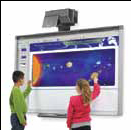
Solution: The district installed approximately 1,300 SMART Board interactive whiteboards and 1,300 SMART document cameras. There will be a SMART Board 680i interactive whiteboard system that features the ultra-short-throw SMART UF75 projector and SMART document camera 330 in all core-subject classrooms, including math, science, language arts, and social studies. Even the youngest students will have easy access to the interactive whiteboards via height-adjustable wall mounts.
Using data to measure student success
Challenge: Cincinnati Public Schools needed a way to measure student success solutions and ensure all students are on track to complete an individual plan for success after high school.

Solution: Naviance Succeed, which was recently implemented in 14 high schools, lets users draw data from disparate systems to provide a comprehensive view of where a student is in relation to his or her plan.
